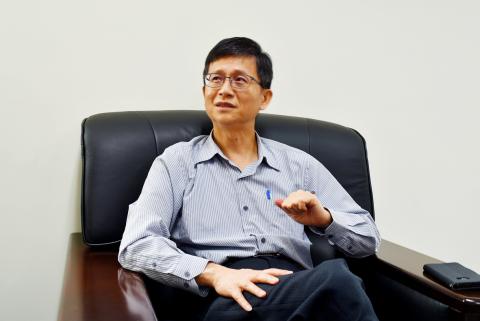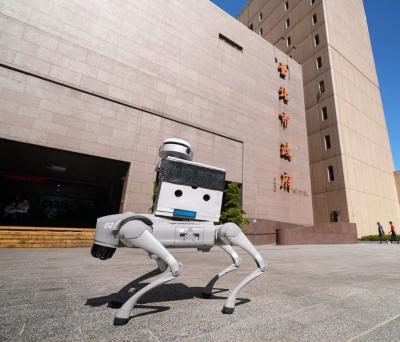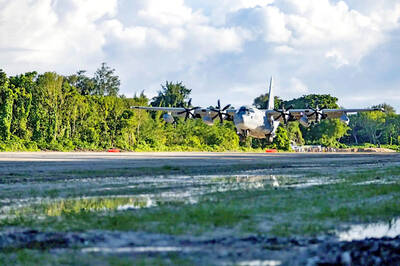Environmental Protection Administration (EPA) Deputy Minister Chan Shun-kuei (詹順貴) addressed the problems involved in offshore wind farming in Taiwan in an interview with the Taipei Times on Thursday.
“Development is not always wrong. Sometimes it is the location that is the problem,” he said, showing that he is not an indiscriminate opponent to economic development even though he often sides with the disadvantaged in land development issues.
Since the beginning of this year, the EPA has received 22 environmental impact assessment (EIA) applications from offshore wind-farm developers.

Photo: Lin Chia-nan, Taipei Times
However, most were required to make up for their insufficient ecological studies.
Fuhai Wind Farm Co’s project off the coast of Changhua County last month was the first to undergo a second-stage EIA, mainly because it is near wetlands and Taiwanese humpback dolphin habitats in waters 15m deep.
Another developer, Wpd Taiwan Energy, withdrew an EIA application later last month due to “new environmental impact factors.”
The EPA’s newly drawn dolphin habitat chart compelled the firm to re-evaluate whether to continue the project, a representative told reporters on Monday last week.
“If we had acquired the information earlier, we would not have chosen the site,” the representative added.
However, Chan said the habitat chart was not new information, because the Bureau of Energy was aware of the habitat.
“The bureau did not provide the applicants with sufficient information,” he said. “Now that we make the EIA criteria very clear, developers know our attitude about locations. They cannot bet on chance anymore.”
“The agencies in charge of economic development and construction did not have environmental awareness when making policies before. They often supposed the EPA or its EIA procedures could tackle all environmental issues,” Chan said.
“However, the sites were often in environmentally sensitive areas, so the plans stalled in EIA review and were followed by much controversy and opposition,” he said.
Amid increasing pressure on “green” energy development, Chan did not conceal his dissatisfaction with the economic agencies.
The Bureau of Energy has not even published available routes for cables and a fairway near the Mailiao Industrial Harbor, which affects all offshore projects, he said.
His blame is not unfounded, as official plans for offshore wind farms appear to be inconsistent.
The Executive Yuan in 2012 launched the “Thousand Wind Turbines Promotion Project,” and the next year, the bureau selected three companies — Fuhai, Formosa 1 Wind Power Co and Taiwan Power Co (Taipower) — to develop offshore wind turbines.
In 2015, the bureau published the Regulations on Offshore Wind Power Planned Sites along with 36 sites from which developers could choose.
They were required to pass EIAs by the end of this year to obtain construction permits.
However, it was not until the second half of last year that the EPA began to conduct strategic environmental assessment (SEA), which form the basis for all subsequent impact assessments.
The initial SEA concluded that offshore wind farm projects must be at least 1km away from dolphin habitats near the shore, and that sites farther from the potential fairway should be built first.
With more projects failing EIAs, the bureau last month said it is to work with the Ministry of Science and Technology to build a marine studies database for offshore wind-farm projects.
“The logic of the entire policy is inverted,” Chan said. “A basic investigation should be done first, followed by site planning, an overall SEA and individual EIAs.”
“The policy was initiated by former president Ma Ying-jeou’s (馬英九) administration, which was basically pro-nuclear,” he said. “Its ‘Thousand Wind Turbines’ project just aimed to cater to the trend, but most of the policy was perfunctory.”
In comparison, President Tsai Ing-wen’s (蔡英文) government is determined to “turn fiction into reality,” Chan said.
If the bureau could realize its promise to delineate a fairway by the middle of this month, most of the projects off Changhua could pass EIAs by October, and their aggregate capacity could reach 7.6 gigawatts, more than double the 3 gigawatts envisioned by the bureau, he said.
“The EIAs can be delayed, but the criteria should be crystal clear. The plans that can pass EIAs should be passed as soon as possible. As for those that cannot pass, we should let the developers know earlier,” he said, adding that Tsai and Premier Lin Chuan (林全) also share the position.
In addition to the assessments, the industrial chain for offshore wind farms has much room for improvement, Chan said.
“While China Steel Corp [CSC] is painfully learning to build turbines with between 4 megawatts [MW] and 5MW capacity each, most developers have planned to use turbines with between 6MW and 8MW capacity and the Europeans have even developed turbines with capacity of between 10MW and 16MW,” he said.
Taiwanese industries do not yet have the ability to build wind turbine blades and supporting columns, he said.
“Such industrial localization is superficial, as the knowledge would lose competitiveness soon,” he said, adding that domestic companies should acquire knowledge that has a “shorter learning curve.”
Cable and optical fiber manufacturing, offshore electricity management skills and machine maintenance at ports — among other marine engineering work — would be a good place to start, he said.
“If our businesses are to invest in Southeast Asia, will we have competent teams to support the exportation of knowledge?” he said.
To pave the way for an offshore wind energy industry, CSBC Corp, Taiwan and CSC play leading roles, Chan said.
However, all these plans should be consolidated by one prerequisite: sufficient understanding of the Taiwanese environment onshore and offshore, he said, adding that the bureau’s plan to build the marine database is “better late than never.”
While renewable energy is still a fledgling industry in Taiwan, the government’s plan for a “nuclear-free homeland” by 2025 faces renewed criticism whenever Taipower has problems with the electricity supply.
Asked if the Cabinet had pressured him to loosen EIA criteria, Chan said Lin never interfered in his decisions.
“The premier has listened to my opinions about EIAs ever since he worked at the Democratic Progressive Party’s think tank,” he said.
Chan said he might not have much latitude to realize his ideals if the premier changes and added that he is determined to work with the premier during his tenure.

The inspection equipment and data transmission system for new robotic dogs that Taipei is planning to use for sidewalk patrols were developed by a Taiwanese company, the city’s New Construction Office said today, dismissing concerns that the China-made robots could pose a security risk. The city is bringing in smart robotic dogs to help with sidewalk inspections, Taipei Deputy Mayor Lee Ssu-chuan (李四川) said on Facebook. Equipped with a panoramic surveillance system, the robots would be able to automatically flag problems and easily navigate narrow sidewalks, making inspections faster and more accurate, Lee said. By collecting more accurate data, they would help Taipei

STATS: Taiwan’s average life expectancy of 80.77 years was lower than that of Japan, Singapore and South Korea, but higher than in China, Malaysia and Indonesia Taiwan’s average life expectancy last year increased to 80.77 years, but was still not back to its pre-COVID-19 pandemic peak of 81.32 years in 2020, the Ministry of the Interior said yesterday. The average life expectancy last year increased the 0.54 years from 2023, the ministry said in a statement. For men and women, the average life expectancy last year was 77.42 years and 84.30 years respectively, up 0.48 years and 0.56 years from the previous year. Taiwan’s average life expectancy peaked at 81.32 years in 2020, as the nation was relatively unaffected by the pandemic that year. The metric

TAKING STOCK: The USMC is rebuilding a once-abandoned airfield in Palau to support large-scale ground operations as China’s missile range grows, Naval News reported The US Marine Corps (USMC) is considering new sites for stockpiling equipment in the West Pacific to harden military supply chains and enhance mobility across the Indo-Pacific region, US-based Naval News reported on Saturday. The proposed sites in Palau — one of Taiwan’s diplomatic allies — and Australia would enable a “rapid standup of stored equipment within a year” of the program’s approval, the report said, citing documents published by the USMC last month. In Palau, the service is rebuilding a formerly abandoned World War II-era airfield and establishing ancillary structures to support large-scale ground operations “as China’s missile range and magazine

A 72-year-old man in Kaohsiung was sentenced to 40 days in jail after he was found having sex with a 67-year-old woman under a slide in a public park on Sunday afternoon. At 3pm on Sunday, a mother surnamed Liang (梁) was with her child at a neighborhood park when they found the man, surnamed Tsai (蔡), and woman, surnamed Huang (黃), underneath the slide. Liang took her child away from the scene, took photographs of the two and called the police, who arrived and arrested the couple. During questioning, Tsai told police that he had met Huang that day and offered to